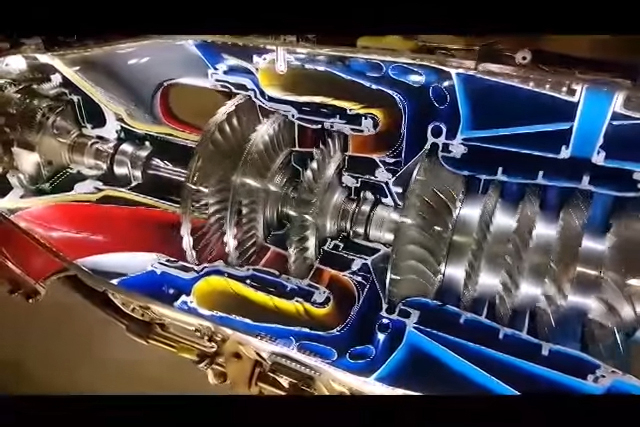The highly-reliable Pratt & Whitney PT6 is one of the most widely-used turboprop engines in the world, with different models of the powerplant used in everything from US military aircraft like the Beechcraft U-21 Ute to automotive duty in the STP-Paxton Turbocar raced in the 1967 Indy 500 and Lotus 56 raced in the 1968 Indy 500 and later Formula One races.
 In this quick video, we get a quick look at the innards of the PT6 design, with each of the airpaths fully decked out in bright paint to designate their direction of flow. The different styles of PT6 engine range from 500 all the way up to 2,000 shaft horsepower and use many concepts similar to automotive engines. The power turbine and propeller shafts use a fluid coupler similar in theory to an automotive torque converter; it’s driven by the exhaust gas only — there is no direct connection. The gas generator and power turbine section are independent of one another, with the exhaust from the jet engine spinning the propeller via what’s called a “free turbine” arrangement, which can be seen here in more detail.
In this quick video, we get a quick look at the innards of the PT6 design, with each of the airpaths fully decked out in bright paint to designate their direction of flow. The different styles of PT6 engine range from 500 all the way up to 2,000 shaft horsepower and use many concepts similar to automotive engines. The power turbine and propeller shafts use a fluid coupler similar in theory to an automotive torque converter; it’s driven by the exhaust gas only — there is no direct connection. The gas generator and power turbine section are independent of one another, with the exhaust from the jet engine spinning the propeller via what’s called a “free turbine” arrangement, which can be seen here in more detail.
There are two compressor sections; a low-pressure axial section mounted just aft of the air inlet, then the airflow progresses into the single-stage centrifugal compressor, similar to a ProCharger or Vortech supercharger in the automotive world. The airflow then passes through the reverse-flow combustion chamber and into the single-stage turbine section that spins approximately 45,000 rpm. From there, it’s off to the power section that uses a single-stage power turbine that drivers the power take-off system at approximately 30,000 rpm. In turboprop applications, the PTO system drives a two-stage planetary reduction gearbox that drives the propeller at 1,900 to 2,200 rpm. Aircraft installations have the PT6 mounted backwards with the power section of the powerplant facing forward to drive the propeller directly.
In the video, the blue sections are the “cold” side, with the exhaust side depicted in red. It’s an interesting look at the internals of one of the most popular aircraft engines ever made.





















